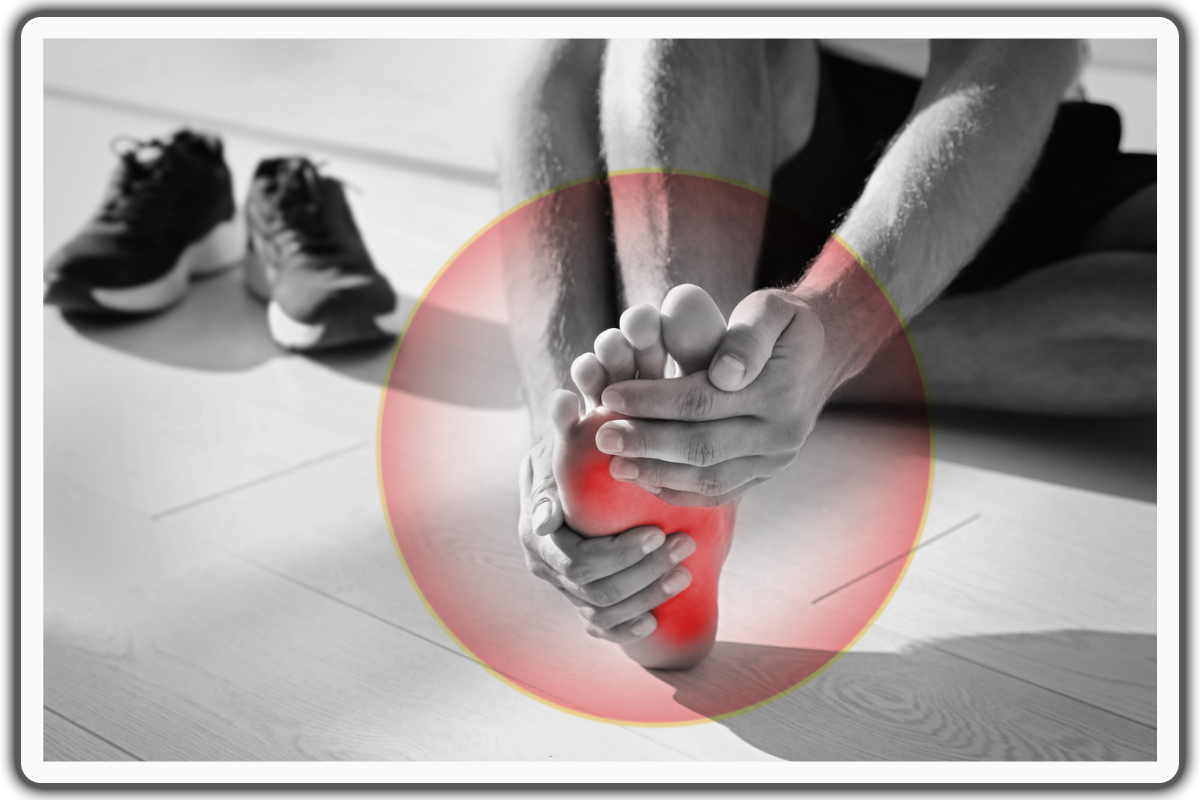
Physical Therapy for Foot Pain: The 7 Best Foot Exercises For Relief
Are you tired of every step being a painful reminder of your foot issues and looking for relief that goes beyond temporary solutions? Check out the best physical therapy for foot pain recommended by experts and professionals, incorporating the 7 best foot exercises for relief.
It's time to make every step count. The wonders of healthy feet extend beyond mere mobility; they encompass the freedom to enjoy life to the fullest. Start your journey toward long-term recovery today.
Understanding Foot Pain and Its Causes
Foot pain can be a crippling ailment that affects individuals of all ages and lifestyles. It can significantly impact daily activities, making walking, exercising, or even standing difficult. Various factors that contribute to foot pain include:
Overuse or Injury:
Running, jumping, or standing for prolonged periods can result in overuse injuries like plantar fasciitis, Achilles tendonitis, or stress fractures. Physical injury resulting from direct trauma, such as accidentally dropping a heavy object on the foot or experiencing an ankle twist, can also lead to acute injuries, resulting in pain.
Foot Structure and Mechanics:
Structural problems in the feet, such as flat arches (pes planus) or high arches (pes cavus), can lead to abnormal stress on the foot and contribute to conditions like plantar fasciitis, bunions, or hammertoes. Poor biomechanics, such as overpronation or supination, can also lead to imbalances and pain.
Footwear:
Ill-fitting or unsupportive footwear can exacerbate foot pain by causing pressure points, rubbing, or inadequate support. High heels, narrow-toe boxes, and worn-out shoes can contribute to conditions like bunions, corns, or ingrown toenails.
Medical Conditions:
Certain medical conditions can manifest as foot pain. Arthritis, diabetes, nerve disorders (such as peripheral neuropathy), and circulatory issues can all cause or contribute to foot pain symptoms.
Infections:
Fungal infections (such as athlete's foot), bacterial infections (such as cellulitis), or viral infections (such as plantar warts) can cause discomfort and pain in the feet.
Lifestyle Factors:
Obesity, poor posture, and lack of proper foot care can increase the risk of foot pain by putting excessive stress on the feet or leading to biomechanical imbalances.
Understanding the underlying cause of foot pain is essential for appropriate treatment and management.
Common Types of Foot Pain and Their Treatment Options
Foot and ankle pain can manifest in various forms, requiring specific treatment approaches. Here are some common types of foot pain and their corresponding treatment options:
Plantar Fasciitis: This condition involves plantar fascia inflammation, a dense tissue connecting the heel bone to the big toe joint. Treatment options include stretching exercises, orthotics, night splints, plantar fascia stretch, and physical techniques like ultrasound and manual therapy.
Achilles Tendinitis: This condition pertains to the inflammation of the Achilles tendon, linking the calf muscles to the heel bone.
Rest, ice, and physical therapy exercises aimed at strengthening the calf muscles are among the available treatment options to strengthen the calf muscles, and orthotic devices to support and relieve pressure on the tendon.
Metatarsalgia: Inflammation and pain in the ball of the foot result from this condition. Options for treatment encompass physical therapy exercises aimed to strengthen the surrounding muscles, padding or shoe inserts to relieve pressure, and footwear modifications.
Morton's Neuroma: This condition results from the thickening of the tissue surrounding the nerves that extend to the toes, resulting in pain and discomfort. Treatment options include physical therapy techniques such as ultrasound therapy, stretching exercises, and footwear modifications.
Bunions refer to the development of bony protrusions on the joint at the base of the big toe, resulting in pain and deformity. Options for treatment encompass physical therapy exercises aimed at strengthening the muscles in the surrounding muscles, orthotic devices for support, and footwear modifications.
Stress Fractures: Stress fractures, small cracks in the bones commonly caused by overuse or repetitive stress, can result in heel pain, ankle sprains, or strain on the calf muscle. Treatment options include:
Post-Surgical Rehabilitation: Physical therapy is essential after foot surgery to promote healing, restore mobility, and prevent complications. It may involve exercises, manual therapy, gait training, and other techniques tailored to the individual's needs. Additionally, patients perform balancing exercises regularly to enhance stability and minimize the likelihood of falls or injuries.
7 Best Foot Pain Physical Therapy Exercises
Below are seven highly effective exercises specifically designed to alleviate and relieve pain, targeting various areas of discomfort and contributing to enhanced foot health and overall well-being:
1. Heel Rotations
Begin in an upright standing position with your feet hip-width apart, maintaining good alignment with your head, shoulders, hips, and legs. Bring your right foot forward and transfer 75% of your body weight to your front leg. Engage your core and gently move your heel in a circular motion. After several repetitions, return to the starting position and repeat the movement in the opposite direction. Start with 3 repetitions on each side.
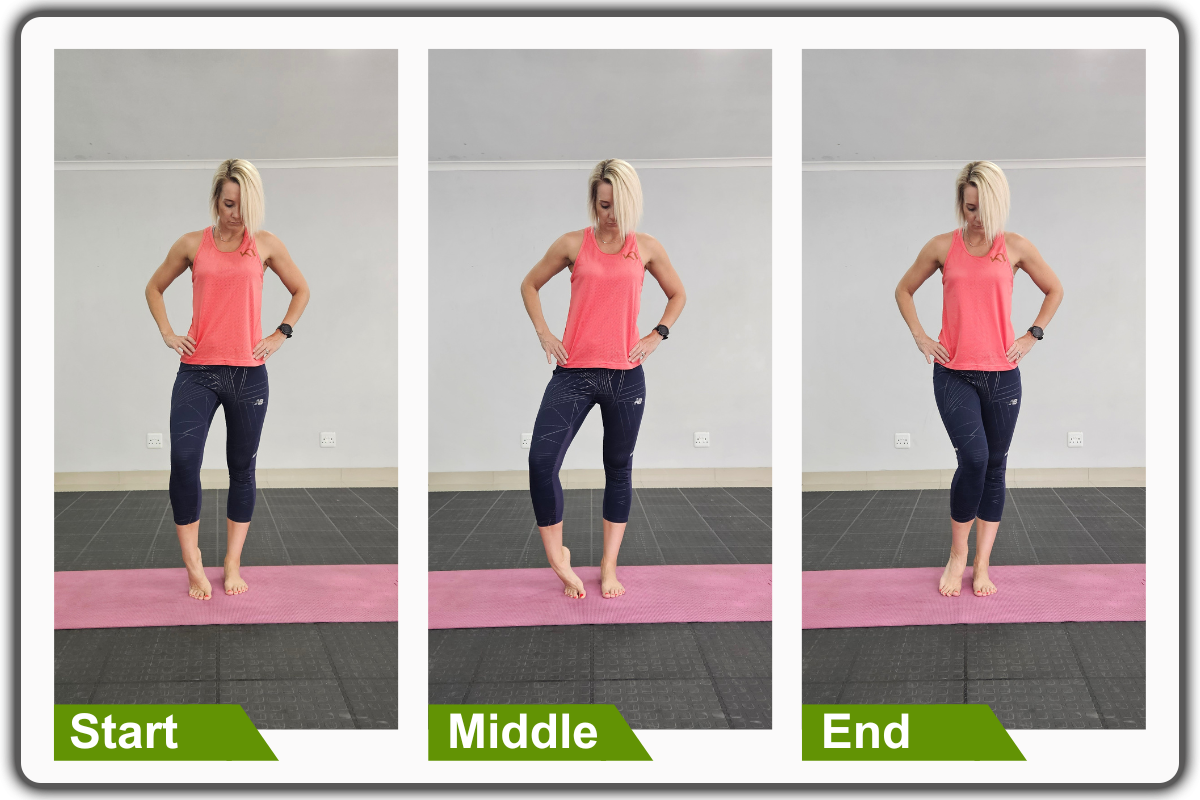
2. Foot Inversion
For this foot pain exercise, begin in an upright standing position with your feet hip-width apart, maintaining good alignment with your head, shoulders, hips, and legs. Engage your core and step one foot forward. While keeping both knees straight, slowly shift your body weight on the outer edge of your front foot. Flatten your foot down to return to the starting position and repeat the movement. Start with 1 set of 3 repetitions on each side.
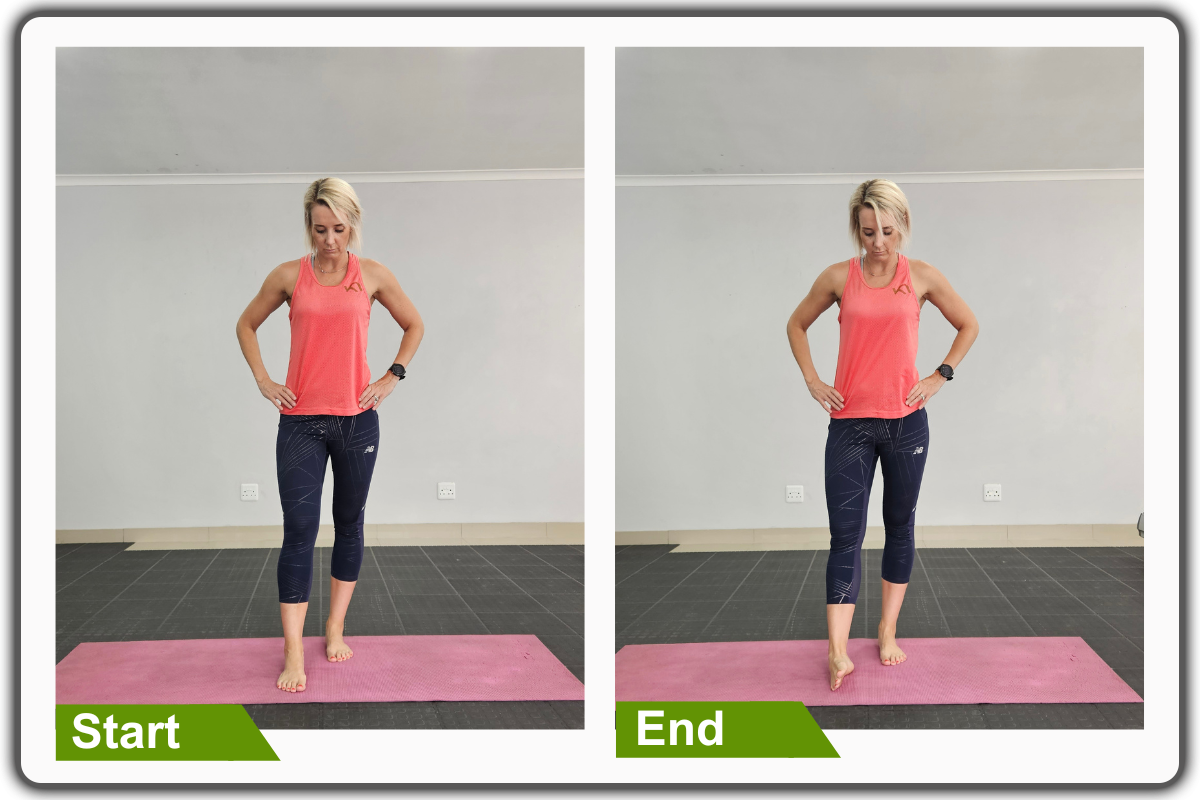
3. Foot Extension
For this exercise, utilize the back of the chair or wall for support if needed.
Begin in an upright standing position with your feet hip-width apart, maintaining good alignment with your head, shoulders, hips, and legs. Step your right leg back, stacking your heel over your toes. Transfer your body weight to your other leg and slightly lean forward, pressing on your toes. Hold this position for a few seconds. Return to the starting position and repeat the movement on your other foot. Start with 1 set of 3 repetitions on each foot.
To intensify the stretch, roll a sock or a small towel between your toe gaps as you perform the movement.
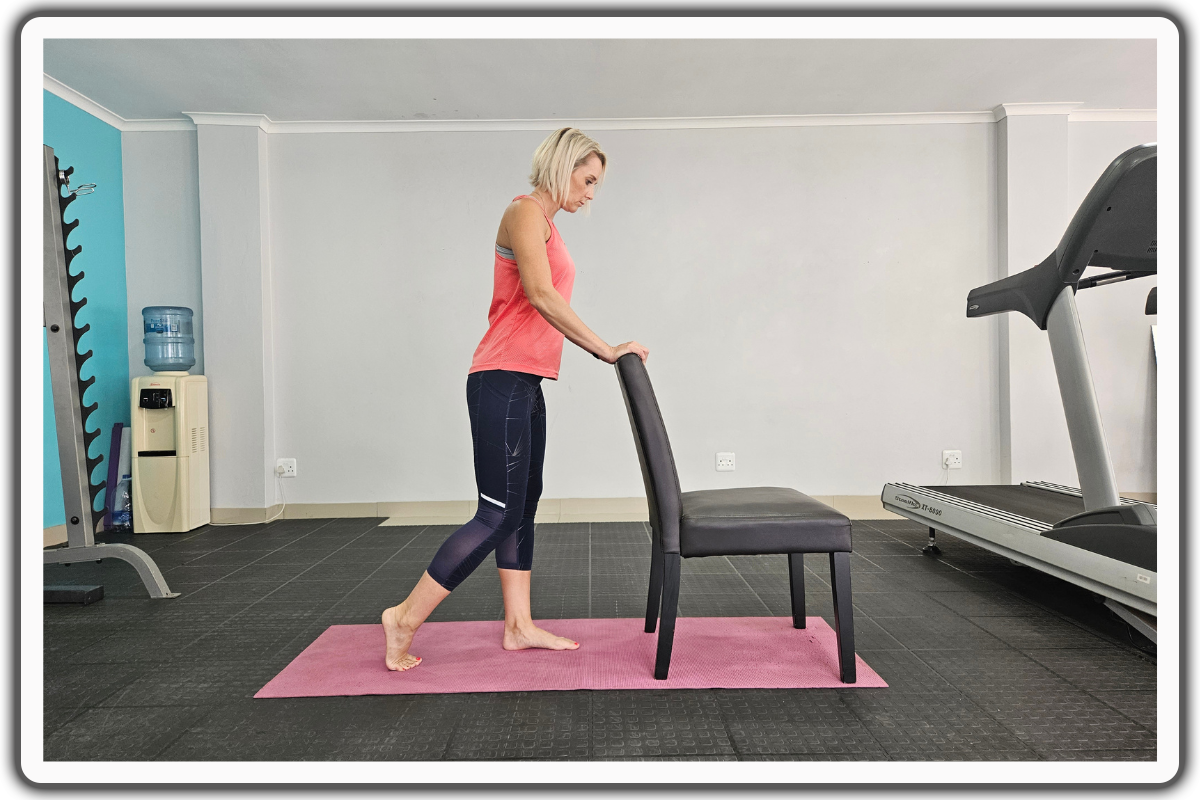
4. Foot Flexion
For this foot exercise, utilize the back of the chair or wall for support if needed.
Begin in an upright standing position with your feet hip-width apart, feet flat on the floor, and maintaining good alignment with your head, shoulders, hips, and legs. Step your right leg back with your toes tucked under your heel and transfer your body weight to your other leg. Slightly bend your knees and gently shift some of your weight to apply pressure against your curled toes. Hold this position for a few seconds and repeat the movement on your other foot. Start with 1 set of 3 repetitions on each foot.
To intensify the stretch, roll a sock or a small towel between your toe gaps as you perform the movement.

5. Plantar Flexion and Dorsiflexion
Begin in an upright sitting position on the floor with your legs extended in front of you, maintaining good alignment with your head, shoulders, and hips. Bend one knee and hold the back of your thigh with both hands as you lift your foot off the floor. Working on the range of motion in the ankle joints, point your toes toward the floor, then alternate the movement by flexing your ankles to lift your toes toward the ceiling. Perform for 3 repetitions in each direction. Repeat the movement on the other foot.
To make this foot pain exercise more challenging, perform the movement with your leg straight for a deeper stretch.
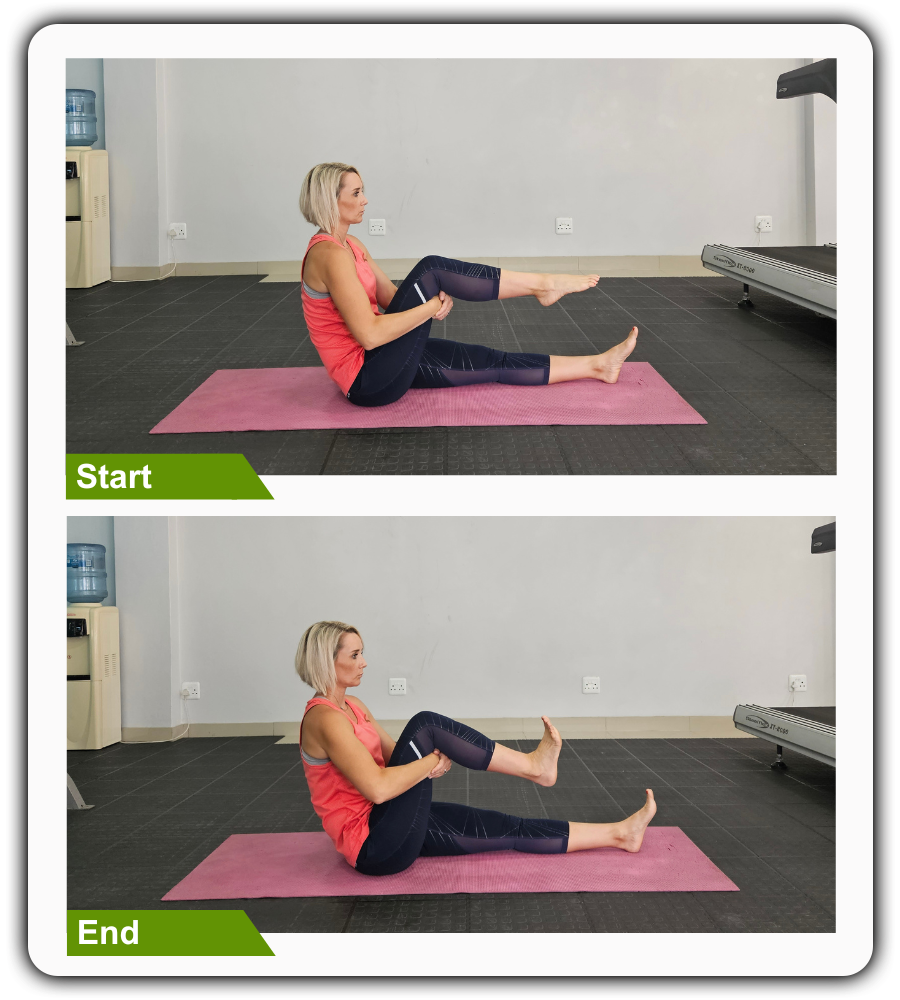
6. Angled Foot Coordination
For this foot pain exercise, begin in an upright sitting position on the floor with your legs extended in front of you, maintaining good alignment with your head, shoulders, and hips. Slightly bend one knee and hold the back of your thigh with both hands as you lift your foot off the floor. Flex your ankle, lifting your toes toward the ceiling. Pivot your foot in an angled inward and outward direction, holding each end position for a couple of seconds. Return to the starting position and repeat the movement on the other leg. Perform the movement for 1 set of 3 repetitions on each leg.
To intensify this movement, perform this foot exercise with your knee straight.
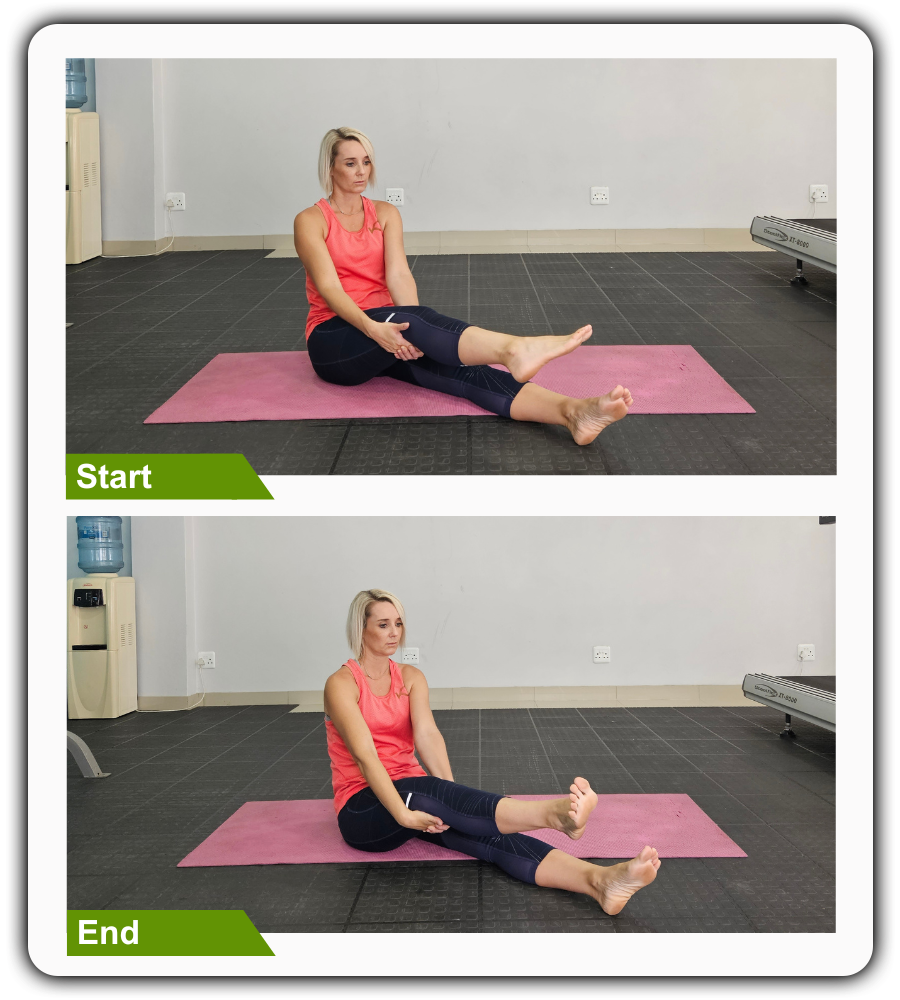
7. Marble Pick-up
Begin in an upright sitting position on a chair with your knees bent and feet flat on the floor. Maintain a good alignment with your head, shoulders, and hips. Place some marbles or small objects and a container on the floor in front of you. Pick up one marble at a time with your toes and place it in the container. Continue until you’ve picked up all the marbles.
You can start with a small number of marbles and gradually increase the quantity as your toe strength and dexterity improve.
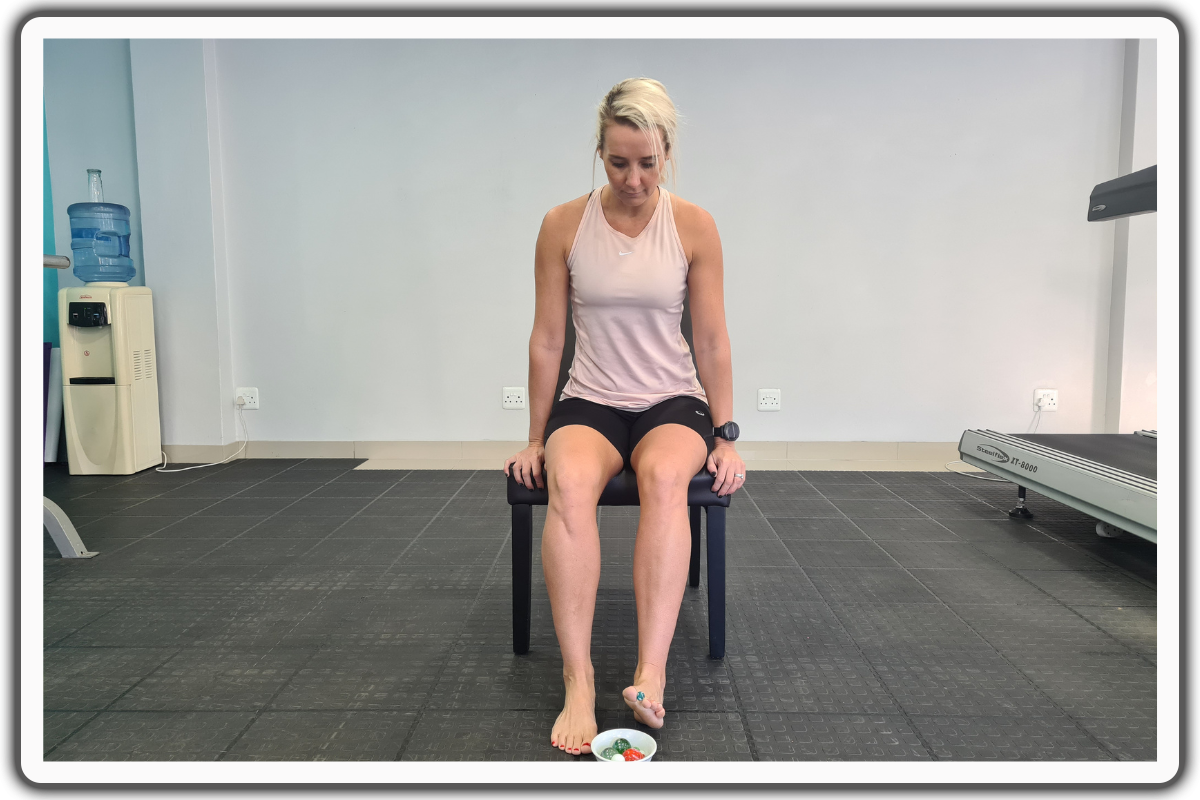
When to Seek Physical Therapists for Your Foot Pain
Here are some signs that indicate it's time to seek assistance:
Severe or Worsening Pain: If your foot pain is severe, worsening, or affecting your daily activities despite conservative measures, it is important to consult a healthcare professional for further evaluation.
Difficulty Walking or Standing: If your foot pain is causing significant difficulties in walking, standing, or bearing weight, it is advisable to seek professional guidance to prevent further injury or complications.
Swelling or Redness: If you notice swelling, redness, warmth, or signs of infection in your foot, it could suggest a more severe underlying issue that necessitates medical intervention.
Numbness or Tingling: Persistent numbness, tingling, or loss of sensation in your foot suggests potential nerve involvement and warrants assessment by a healthcare professional.
Recurring or Chronic Foot Pain: If you've experienced persistent or chronic foot pain that hasn't improved with previous treatments, it is recommended to consult with a specialist for a comprehensive assessment and a more comprehensive treatment plan.
Foot Deformity: If you notice any significant foot deformities or changes in the shape or structure of your foot, it is important to seek professional evaluation to prevent further complications.
Remember, seeking professional help early can prevent potential complications and ensure the most appropriate and effective treatment for your foot pain.
Tips for Preventing and Managing Foot Pain in the Long Term
Prevention is key when it comes to foot pain. Here are some tips to prevent and manage foot pain in the long term:
Choose Proper Footwear: Wear shoes that fit well, provide adequate support, and are appropriate for your activities. Avoid high heels, narrow-toed shoes, or shoes with minimal cushioning.
Maintain a Healthy Weight: Excess weight puts additional stress on your feet and can contribute to foot pain. Maintain a healthy weight through a balanced diet and regular exercise.
Practice Good Foot Hygiene: Keep your feet clean and dry to prevent fungal infections or other foot conditions. Trim your toenails regularly and wear breathable socks made of natural fibers.
Listen to Your Feet: Pay attention to any changes, discomfort, or pain in your feet. Addressing minor issues early can prevent them from progressing into more severe conditions.
Conclusion:
Foot pain can have a substantial effect on your everyday activities. However, with the right guidance, you can manage it effectively and work towards lasting relief and recovery. Physical therapy provides personalized care to address the root cause of foot pain, promoting natural healing through targeted exercises and complementary treatments. Integrating these therapies into your routine and adopting preventive measures can improve mobility, alleviate pain, and prevent future issues. Seek guidance from a physical therapist or healthcare expert to create a customized treatment plan, embarking on the path to a lifestyle that is both active and free from pain.
